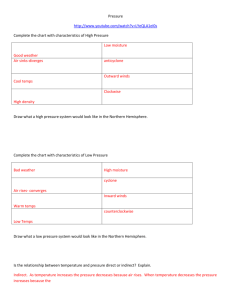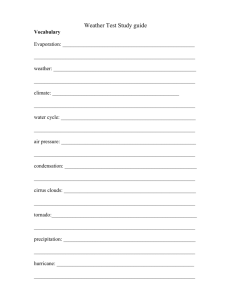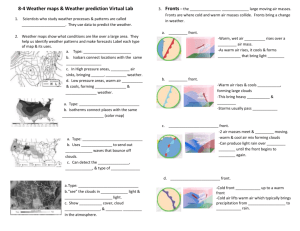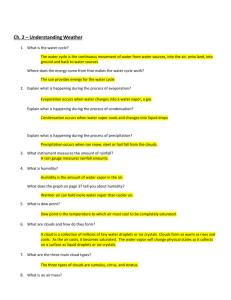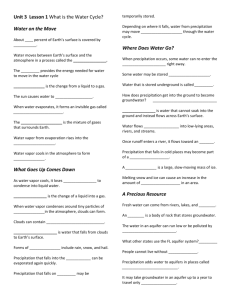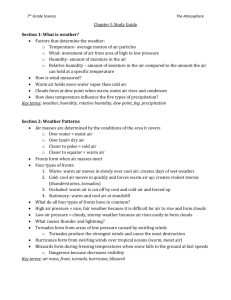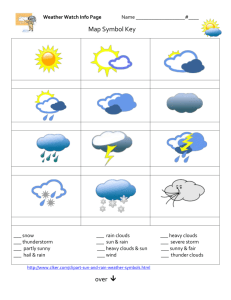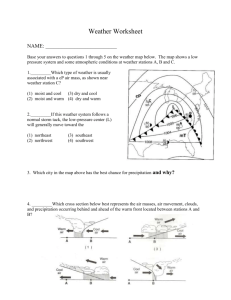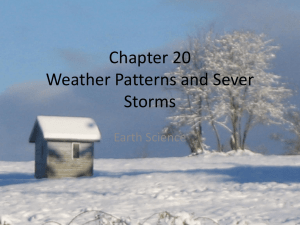File - Science with Spence
advertisement
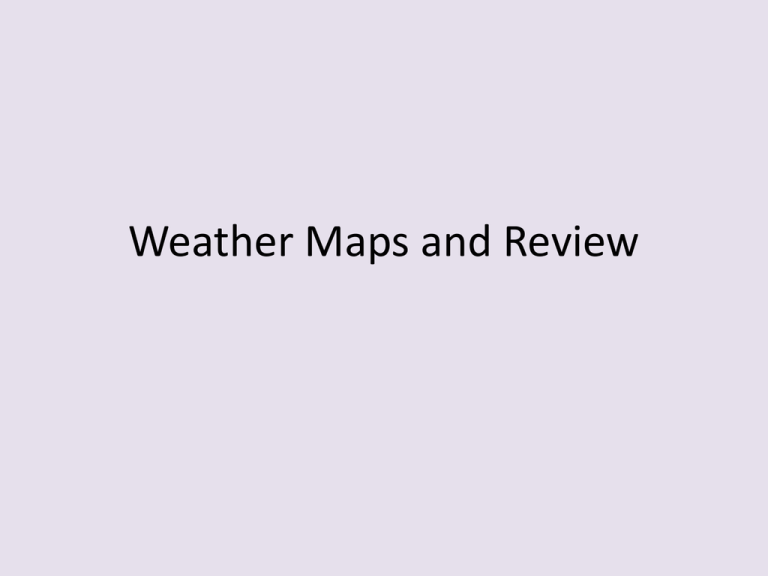
Weather Maps and Review Answer on the front of the notecard. Keep the back clean!! A 1. 2. 3. 4. 5. 6. B C What front is represented by symbol A? What air mass is moving in A? In which direction? What front is represented by symbol B? What air mass is moving in B? In which direction? What front is represented by symbol C? A body of air with similar temperature, humidity, and air pressure is called ____. 7. An area where two air masses meet is called___. 8. Horizontal movement of air from High pressure to low pressure is called ____. Answer on the front of the notecard. Keep the back clean!! A B C 1. What front is represented by symbol A? Warm Front 2. What air mass is moving in A? In which direction? Warm Air is moving Northwest over a cold air mass. 3. What front is represented by symbol B? Cold Front 4. What air mass is moving in B? In which direction? Cold Air is moving Southeast pushing warm air up. 5. What front is represented by symbol C? Stationary front 6. A body of air with similar temperature, humidity, and air pressure is called ____________. 7. An area where two air masses meet is called ___________. 8. Horizontal movement of air from High pressure to low pressure is called ___________. 6. A body of air with similar temperature, humidity, and air pressure is called an air mass. 7. An area where two air masses meet is called a front. 8. Horizontal movement of air from High pressure to low pressure is called wind. Review Station Models What is represented by these values? Give a definition. • A. • B. • C. • D. • E. • F. Review Station Models • • • • • • A. Temperature B. Observed Weather C. Dew Point D. Air Pressure (current) E. Cloud Coverage F. Wind Direction and Speed On the front of the notecard… Keep the backside clean. 1. Along a front, which air is always forced up? A. B. C. D. The wettest air Warmer, less dense air The fastest moving air The driest air 2. High pressure systems usually are associated with ____ and low-pressure systems are associated with ___. A. B. C. D. Clouds and precipitation, fair weather The jet stream, fronts Fair weather, clouds and precipitation Fair weather, fair weather 3. In the Northern Hemisphere, winds in a cyclone blow___. A. B. C. D. Clockwise toward the center Counter-clockwise toward the center Sometimes clockwise other time straight Clockwise outward from the center 4-6 are on the next slide… save space!! 4. Draw this front. To show where the warm and cold air is located, write the words “warm” and Cold” on the proper side of each front below. 5. Which direction is the warm front moving? 6. Which direction is the cold front moving? ANSWERS 1. Along a front, which air is always forced up? A. B. C. D. The wettest air Warmer, less dense air The fastest moving air The driest air 2. High pressure systems usually are associated with ____ and low-pressure systems are associated with ___. A. B. C. D. Clouds and precipitation, fair weather The jet stream, fronts Fair weather, clouds and precipitation Fair weather, fair weather 3. In the Northern Hemisphere, winds in a cyclone blow___. A. B. C. D. Clockwise toward the center Counter-clockwise toward the center Sometimes clockwise other time straight Clockwise outward from the center 4-6 are on the next slide… save space!! 4. Draw this front. To show where the warm and cold air is located, write the words “warm” and Cold” on the proper side of each front below. 5. Which direction is the warm front moving? NNE 6. Which direction is the cold front moving? SE • Extra Credit Opportunity: Create a Station Model for any city in the US. You need to print the weather data and turn it in with the correctly labeled station model. (5 pts.) • DUE ON FRIDAY! No LATE accepted… • Must be your own work. No copied cities/data. • I will put the sheet online later today for you to complete. 6/3– 6/7 • Mon.- Work on Study Guide • Tues.- Finish Study Guide and Review for Test • Wed.- Study For Weather Test Friday • Thurs.- Study For Weather Test Tomorrow • Fri.- Weather Test Today: Extra Credit due today. • Extra Credit Opportunity: Create a Station Model for any city in the US. You need to print the weather data and turn it in with the correctly labeled station model. (5 pts.) I will put the sheet on the website later today. 9. What is the name of the global wind pattern that goes between the equator and 30* N or S latitude? 10. What pressure would you expect at the North Pole? Why? Use the station model to answer #11-16. 11. What is the temperature? 12. What is the current air pressure? 13. What is the wind direction and speed? 14. What is the dew point? 15. What was the past air pressure? 16. What weather would you expect given this data? Why? 9. What is the name of the global wind pattern that goes between the equator and 30* N or S latitude? Trade winds 10. What pressure would you expect at the North Pole? Why? High Pressure, cold air is more dense so it is condensed and will have higher pressure. Use the station model to answer #11-16. 11. What is the temperature? 98* F 12. What is the current air pressure? 1012.4 mb 13. What is the wind direction and speed? Southeast, 15 knots 14. What is the dew point? 78*F 15. What was the past air pressure? 1012.4 + 0.3 = 1012.7 mb 16. What weather would you expect given this data? Why? Weather Maps • “Snapshot” of weather conditions at a time in a large area. • May contain Station Model data, variations in color, isobars, isotherms, fronts, other weather symbols. • Isobars- lines that join places of equal air pressure. • Isotherms- lines that join places of the same temperature. Which area will have the highest wind speed? A B C D 1. What colors represent the highest temps? Lowest? 2. What city has the highest temp? lowest? 3. How many different fronts are in the map? Name them. 4. How many areas of Low pressure? High pressure? 5. Predict: What season is this? How do you know? 6. What weather will happen in Minneapolis tomorrow? Scanned pic from worksheet make ½ sheet for students to do? 1. List the different fronts shown on the weather map. 2. Which kind of air mass would the north Atlantic be in? Explain. 3. In what direction is the front near Phoenix moving? 4. What kind of front is near Denver? What weather did they probably just experience? 5. What kind of front is north of Chicago? What will it mean for Chicago’s weather over the next few days? 6. What kind of air mass would be over Great Falls? Explain. 7. Would LA have clear or cloudy skies? Explain. 8. What kind of air mass would Washington D.C. experience? 9. What kind of weather will Kansas City experience in the next day or two? 10. What kind of air mass is Atlanta experiencing? Study Guide Questions…
